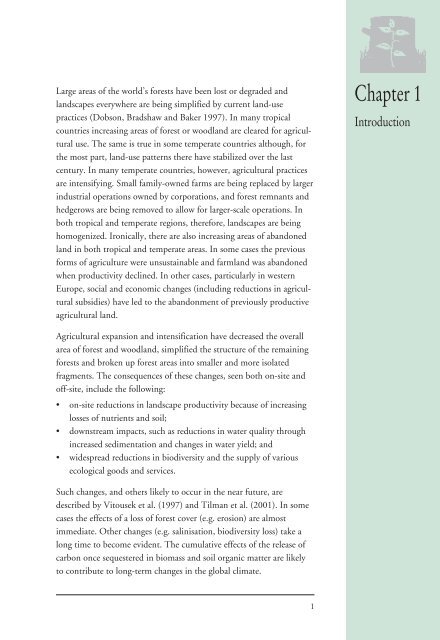Rehabilitation and Restoration Of Degraded Forests (PDF) - IUCN
Rehabilitation and Restoration Of Degraded Forests (PDF) - IUCN
Rehabilitation and Restoration Of Degraded Forests (PDF) - IUCN
You also want an ePaper? Increase the reach of your titles
YUMPU automatically turns print PDFs into web optimized ePapers that Google loves.
Large areas of the world’s forests have been lost or degraded <strong>and</strong><br />
l<strong>and</strong>scapes everywhere are being simplified by current l<strong>and</strong>-use<br />
practices (Dobson, Bradshaw <strong>and</strong> Baker 1997). In many tropical<br />
countries increasing areas of forest or woodl<strong>and</strong> are cleared for agricultural<br />
use. The same is true in some temperate countries although, for<br />
the most part, l<strong>and</strong>-use patterns there have stabilized over the last<br />
century. In many temperate countries, however, agricultural practices<br />
are intensifying. Small family-owned farms are being replaced by larger<br />
industrial operations owned by corporations, <strong>and</strong> forest remnants <strong>and</strong><br />
hedgerows are being removed to allow for larger-scale operations. In<br />
both tropical <strong>and</strong> temperate regions, therefore, l<strong>and</strong>scapes are being<br />
homogenized. Ironically, there are also increasing areas of ab<strong>and</strong>oned<br />
l<strong>and</strong> in both tropical <strong>and</strong> temperate areas. In some cases the previous<br />
forms of agriculture were unsustainable <strong>and</strong> farml<strong>and</strong> was ab<strong>and</strong>oned<br />
when productivity declined. In other cases, particularly in western<br />
Europe, social <strong>and</strong> economic changes (including reductions in agricultural<br />
subsidies) have led to the ab<strong>and</strong>onment of previously productive<br />
agricultural l<strong>and</strong>.<br />
Agricultural expansion <strong>and</strong> intensification have decreased the overall<br />
area of forest <strong>and</strong> woodl<strong>and</strong>, simplified the structure of the remaining<br />
forests <strong>and</strong> broken up forest areas into smaller <strong>and</strong> more isolated<br />
fragments. The consequences of these changes, seen both on-site <strong>and</strong><br />
off-site, include the following:<br />
• on-site reductions in l<strong>and</strong>scape productivity because of increasing<br />
losses of nutrients <strong>and</strong> soil;<br />
• downstream impacts, such as reductions in water quality through<br />
increased sedimentation <strong>and</strong> changes in water yield; <strong>and</strong><br />
• widespread reductions in biodiversity <strong>and</strong> the supply of various<br />
ecological goods <strong>and</strong> services.<br />
Such changes, <strong>and</strong> others likely to occur in the near future, are<br />
described by Vitousek et al. (1997) <strong>and</strong> Tilman et al. (2001). In some<br />
cases the effects of a loss of forest cover (e.g. erosion) are almost<br />
immediate. Other changes (e.g. salinisation, biodiversity loss) take a<br />
long time to become evident. The cumulative effects of the release of<br />
carbon once sequestered in biomass <strong>and</strong> soil organic matter are likely<br />
to contribute to long-term changes in the global climate.<br />
1<br />
Chapter 1<br />
Introduction

















